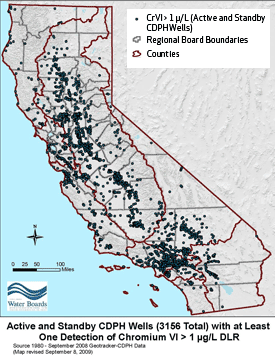
Clean Water Action has been working for almost two decades to establish a California drinking water standard, also known as a maximum contaminant level or MCL, for hexavalent chromium. A 2014 standard was reversed by the courts in 2017 and we’ve spent the past seven years fighting delay tactics by the opposition and advocating for a new, more protective standard than the one adopted a decade ago.
On April 17, 2024 the State Water Resources Control Board (State Board) finally reestablished a drinking water standard for cancer-causing hexavalent chromium at 10 parts per billion (ppb), which is 500 times higher than the state’s public health goal (the level at which significant health effects are not expected) of .02 ppb. While Clean Water Action criticized the Board for not adequately protecting this public, it is thanks to our advocacy, and the support of our members that California is now the first state in the nation to have any regulation on hexavalent chromium. We will continue to push for a more health protective regulation moving forward.
You can read our testimony and press release here.
Background on Hexavalent Chromium in California
The movie “Erin Brockovich” alerted the public to the great suffering the town of Hinkley, CA experienced due to the cancer-causing chemical hexavalent chromium (also known as chromium 6) in its drinking water. While the levels in most other impacted communities are much lower than Hinkley’s, hexavalent chromium was eventually detected in 2475 California drinking water sources, spread throughout 53 out of 58 counties.
Despite the publicity from the film and the severe health effects associated with hexavalent chromium, the federal government has not regulated this toxic chemical in drinking water. Chromium occurs in the environment largely in two forms: trivalent chromium (chromium 3), which is an essential human nutrient, and hexavalent chromium (chromium 6), which is toxic.
Despite this difference, chromium is regulated federally in drinking water as “total chromium” at a level of 50 parts per billion. This standard averages the toxicity of both hexavalent and the less-dangerous trivalent chromium in the water. Since state scientists have determined that the level of hexavalent chromium in drinking water that would not lead to significant health impacts is 0.2 ppb, the combined approach is clearly not adequate to protect public health.
California Takes the Lead - Temporarily
On April 15, 2014, California regulators released a final hexavalent chromium drinking water standard of 10 parts per billion (ppb), making this the only government in the U.S. to regulate the chemical in water. The decision was primarily based on the costs of water treatment. (Learn how drinking water standards are set in California here.) While the standard was not fully health protective, it did provide a starting point from which advocates could push for greater safeguards.
In 2017, public health faced a major setback when the California Manufacturers and Technology Association (CMTA) sued in the Superior Court of Sacramento over the hexavalent chromium regulation. Sadly, the court ruled that the standard was invalid because the state “did not adequately document why the MCL was economically feasible”, versus being based on what would protect Californian’s health and safety. Since then the CMTA has tried to stop other drinking water protections using the same legal strategy, but they have been unsuccessful.
Next Steps

Some water systems chose to protect their consumers by treating the hexavalent chromium in their water even without a legally enforceable standard. However, millions of Californians have continued to be at risk, including children in schools where the water is contaminated and bottled water is unavailable.
State Water Board Drops the Ball
While the State Water Board claimed that reestablishing the standard for hexavalent chromium was a priority, it took seven years for regulators to simply reestablish the same standard they’d had before. In response to the continued delays, Clean Water Action launched a multi-year campaign with allied organizations, impacted communities, and with help from our members. We pressured the Board to stop stalling and advocated for a standard at a health protective level. Clearly our work is not done as we continue to inform the public about the dangers of hexavalent chromium, oversee the implementation of the current standard, and work toward a safer standard over the next 5 years.
Where does hexavalent chromium come from?
In addition to natural sources, hexavalent chromium enters drinking water sources through discharges of dye and paint pigments, wood preservatives, chrome plating wastes, and leaching from hazardous waste sites. Not surprisingly, communities near chromium waste disposal sites or chromium manufacturing and processing plants are at particular risk of exposure. Probably the most impacted people are workers exposed on the job.
What are the health effects of hexavalent chromium?
Hexavalent chromium is a carcinogen and a reproductive toxicant for both males and females. As a result, it was added to California's Proposition 65 list of toxic substances in December 2008. Exposure to hexavalent chromium occurs through breathing, ingestion, and contact with the skin. Although most of the known health impacts are related to inhalation, there is now strong data linking ingestion of hexavalent chromium, such as through drinking water, to severe health effects. In addition to cancer and reproductive harm, short and long-term exposures can lead to eye and respiratory irritation, asthma attacks, nasal ulcers, dermal burns, anemia, acute gastroenteritis, vertigo, gastrointestinal hemorrhage, convulsions, ulcers, and damage or failure of the liver and kidneys.